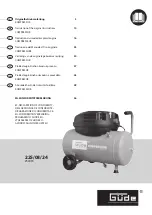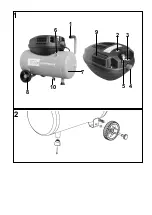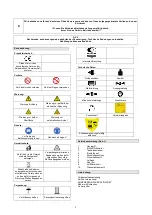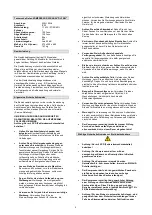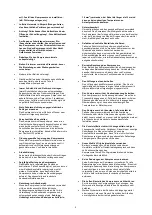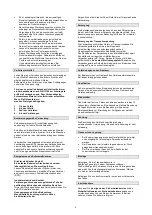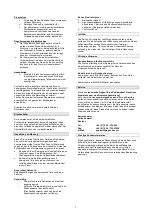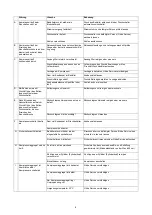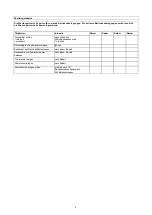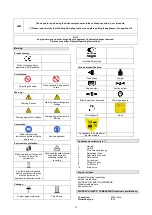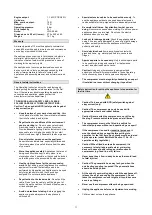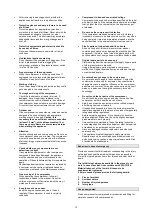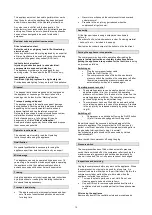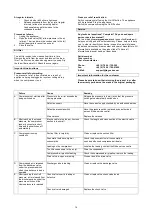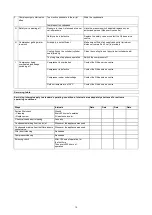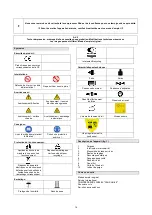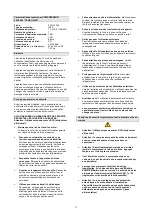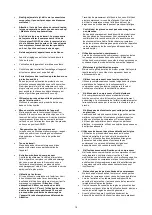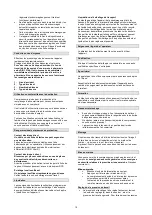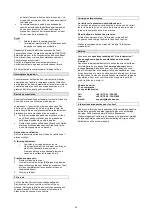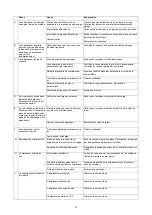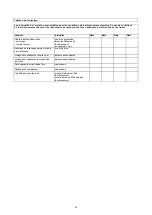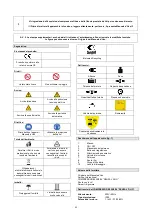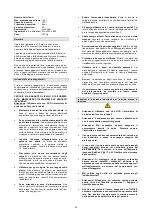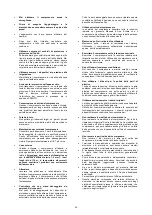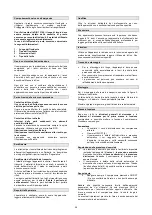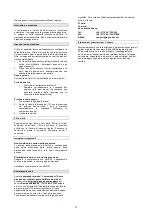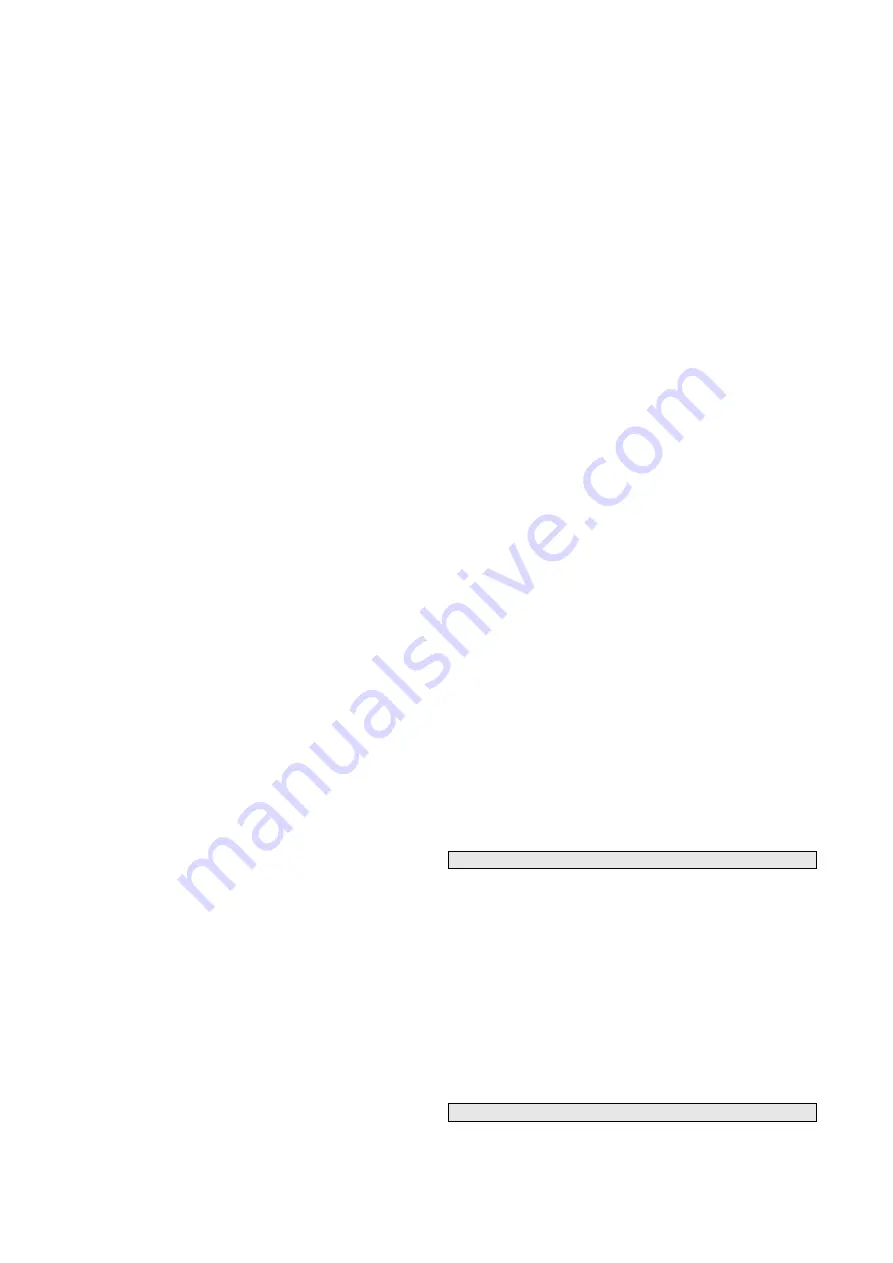
•
After removing the package, check whether the
appliance and all parts are in a perfect condition.
•
Protective glasses and ear protectors to be used
at all times
Protective glasses or appropriate eye and ear
protection to be used at all times. Never aim with the
compressed air stream at your body or other
persons or animals. The air stream may accelerate
undesirable items and they may get dangerously
shot off.
•
Protective equipment against electric shock to
be used at all times
Never use the compressors near water or in wet
conditions.
•
Unintentional appliance starting
Do not transport the compressor if plugged or if the
air jet is pressurised. Before plugging the
compressor, make sure the pressure sensor switch
is in the OFF position.
•
Proper storage of the compressor
When the compressor is not being used, keep it
unplugged in a dry place protected against climatic
influences. Keep out of reach of children.
•
Working clothing
Do not wear loose clothing and jewels as they could
get entangled in the components.
•
Thorough servicing of the compressor
Check the feeder cable at regular intervals. If
damaged, have it repaired or replaced in the
customer service centre. Make sure the outside of
the compressor does not show any visible damage.
Or contact the nearest customer service centre.
•
Outdoor use
If the compressor is used outdoors, extension cables
designed to be used outdoors with appropriate
marking may only be used.
Caution: It is
necessary to use a sufficient cable cross section
(at least 1.5
mm
2
); with cables exceeding 10 m
there may be problems at adverse temperatures
when starting the appliance.
•
Attention
Work cautiously and use common sense. Do not use
the compressor when you are tired. The compressor
must not be used when you are under the influence
of alcohol, drugs or pharmaceuticals that may evoke
tiredness.
•
Check whether any components are not
defective or untight
If any protective equipment or other compressor
components have been damaged, the appliance
must be checked and you must make sure the
operation will be safe before putting it into operation
again.
Any damaged parts must be repaired or replaced by
a customer service centre or replaced based on
instructions mentioned in the maintenance manual.
•
Proper using of the compressor
When operating the compressor, follow all
instructions included in this manual. Do not let
children or persons not familiarised with the way it
works use the compressor.
•
Keep the cowl screen clean
Keep the engine cowl screen clean. Clean it
regularly if the compressor is used in very dirty
conditions.
•
Compressor to be used under rated voltage
Compressor to be used under voltage specified on the label
with electric details. If the compressor is operated at voltage
that is higher than the nominal value, the engine may get
overheated.
•
Do not use the compressor if defective
If the compressor makes abnormal sound or is vibrating
intensively or seems to be defective in any other way when
being operated, it must be immediately stopped; have the
cause identified in the nearest customer service centre.
•
Plastic parts not to be cleaned with solvents
Solvents like petrol, thinners, diesel or other alcohol-
containing substances may damage the plastic parts of the
compressor; therefore, do not clean the plastic parts with
such substances but use lye soap or suitable liquids instead.
•
Original spare parts to be used only
Claims arising from the warranty will not apply if spare parts
of other manufacturers are used.
Using different spare parts may lead to compressor
malfunction. Original spare parts may be obtained through
our authorised dealers.
•
Do not make any change to the compressor
Do not make any change to the compressor. Contact the
customer service centre for any repair. Any unauthorised
change may have a negative influence on the compressor
performance; however, it may also cause serious injuries if
made by a person not having the necessary technical
knowledge.
•
Do not touch the hot parts of the compressor
Do not touch the pipes, engine and other hot parts of the
compressor as there would be a risk of burn.
•
Safety and protective equipment must be refitted properly
after being serviced or repaired.
•
It is absolutely necessary to know the accident prevention
regulations applicable in the place of use and other generally
recognised safety regulations.
•
Before using the appliance, it is necessary to check the
safety equipment. Make sure the visibly slightly damaged
parts are able to work properly.
•
Unless otherwise provided in these Operating Instructions,
any damaged parts and safety equipment must be repaired
or replaced by an authorised service centre.
•
Have any damaged switches replaced in an authorised
service centre.
•
This appliance meets all applicable safety provisions.
Repairs may only be executed by qualified electricians in
authorised service centres, using original spare parts. Risk
of accidents if not adhered to.
Behaviour in case of emergency
Provide necessary first aid treatment corresponding to the injury
nature and seek qualified medical help as soon as possible.
Protect the injured person from other injuries and calm him/her
down.
First aid kit must always be available in the place of your
work in case of accident in accordance with DIN 13164.
Material taken out of the first aid kit needs to be
supplemented right away.
If help is needed, please provide the following details:
1. Place of accident
2. Accident nature
3. Number of injured persons
4. Injury type
Use as designated
Piston compressor for compressed air production and filling for
simple housework with compressed air.
12

